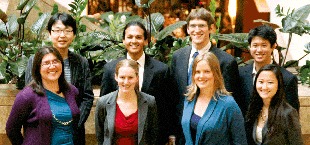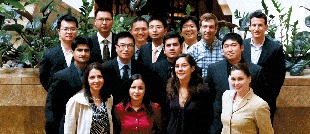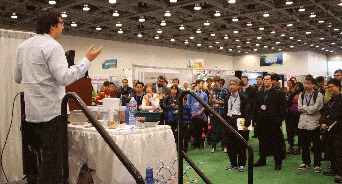The Materials Research Society boasted over 5400 participants attending 54 symposia—11 of which were co-sponsored by the Japan Society of Applied Physics (JSAP)—at the largest Spring Meeting and Exhibit the Society has held yet. Meeting Chairs Lara A. Estroff (Cornell University), Jun Liu (Pacific Northwest National Laboratory), Kornelius Nielsch (University of Hamburg), and Kazumi Wada (University of Tokyo) convened the meeting on April 9–13, 2012 in San Francisco, Calif. In-depth coverage of the technical talks and other meeting events is available at www.mrs.org/meeting-scene. Online proceedings are available as well at www.mrs.org/opl.
Before the technical sessions began, Monday opened with a full day of activities ranging from tutorials and professional development programs to funding opportunities, to forums on the future of biomaterials and on materials and sustainable development. A number of “firsts” happened at this meeting: The inaugural Mid-Career Researcher Award, endowed by Aldrich Materials Science, was given to Kristi S. Anseth of the University of Colorado–Boulder. The first international MRS Student Chapter was announced at King Abdullah University of Science and Technology (KAUST) in Saudi Arabia. Together with new chapters at the University of California–Davis, and the University of California–Irvine, that brings the total to 67 MRS University Chapters worldwide. Among the seminars held about funding available for materials research, this year saw expansions from the traditional government presenters regarding basic research to also include private foundations and some of the various government agencies involved in supporting applied research. And, for the first time, a series of lectures and interviews were captured by video, now available online at www.mrs.org/s12-video.
The Spring Meeting this year also introduced the topic of materials and sustainability, offering a day-long forum on “The many facets of sustainable development,” co-chaired by Ashley White, AAAS Science and Technology Policy Fellow at the National Science Foundation, and Marty Green of the National Institute of Standards and Technology (NIST). The forum also featured the official release of the special April 2012 issue of MRS Bulletin on “Materials for sustainable development” (www.mrs.org/bulletin-april-2012). Green was a co-editor of this special issue, along with Laura Espinal of NIST, Enrico Traversa of the University of Rome, and Eric Amis of United Technologies Research Center.
In his opening remarks at the forum, Green gave a brief history of the concept of sustainable development, maintaining that “sustainability is something you can approach but never achieve—it’s asymptotically approachable.” He said the Stone Age did not end because stones were depleted, but because society found something better. Today, he said, sustainable development is a balance between economic, societal, and environmental factors, and is always a delicate balance. The scientific underpinnings of sustainable development lie in the field of life-cycle assessment. “There is no such thing as sustainable development without the materials science community,” Green said. Because the special issue of MRS Bulletin focuses on the technical areas of manufacturing, transportation, infrastructure, energy and water, and education, the organizers of this forum included speakers from other fields, such as economics, industrial ecology, and venture capital, providing a broad view of this topic. The forum can be viewed in video online.
In a talk that was by turns haunting, moving, and inspirational, plenary speaker Koichi Kitazawa of the Japan Science and Technology Agency gave the audience detailed information about the Fukushima Daiichi Nuclear Plant disaster of March 11, 2011 that was caused by an earthquake followed by the largest tsunami known to have hit Japan. He then discussed the conundrum of Japan reducing its nuclear capacity over the next 10 years while simultaneously trying to meet its international commitment to reduce greenhouse gas emissions by 25% by the year 2020.
“The solution is nanotechnology,” Kitazawa said. “The efforts expended to achieve a ‘game-changing’ technology will encourage our youth to dream. Nano-technology will give us this dream.”
He cited some efforts by Japanese researchers that show promise for renewable energy breakthroughs. One example is research by E. Nakamura of Tokyo University who, working with Mitsubishi Chemical, has commercialized an organic solar cell based on a molecular thin film with an efficiency that is greater than 10%.
“But we need enough space for solar panels and windmills,” Kitazawa said, acknowledging that such a large amount of space does not exist in Japan. Researchers in Japan are investigating offshore, floating windmills that face the materials challenges of being resistant to thunder shock and saltwater corrosion. They are also exploring “solar sharing,” which involves the installation of widely spaced strips of solar panels above the surface of farmlands to let enough sunlight through to allow plants to grow while generating photovoltaic electricity.
Japan’s success in creating long, high-temperature superconducting cables fuels Kitazawa’s ultimate dream to solve the world’s energy problems: a global superconducting grid. “With an east-west grid we can solve the problem of day and night,” he said. “A north-south grid can solve the problem of summer and winter. This is my dream, 30 years from now.”
During the Plenary and Awards ceremony, the Society recognized additional award recipients Stephen J. Pennycook (Oak Ridge National Laboratory; University of Tennessee–Knoxville) for the Innovation in Materials Characterization Award, which is endowed by Gwo-Ching Wang and Toh-Ming Lu; Markus J. Buehler (Massachusetts Institute of Technology) for the Outstanding Young Investigator Award; and the Gold and Silver Graduate Student Awards. The Woody Award, which recognizes a volunteer who has made extraordinary contributions of time and effort to the success of the Society, was given to Paul McIntyre (Stanford University), chair of the MRS Publications Committee. Also Thomas S. Russell (University of Massachusetts–Amherst) received the Fred Kavli Distinguished Lectureship in Nanoscience.
The equipment exhibit included vendors from scientific instrumentation companies, publishing, and scientific services and societies. MRS also hosted the 3rd Annual Technology Innovation Forum, with this year’s topic on Translating Innovation in Materials to Transforming Markets. The Forum provided a stage for innovators, industry leaders, and venture capitalists to discuss their strategic goals, technology needs, market philosophies, funding processes, and lessons learned, with the intent of finding a “materials match” for future fixed and portable energy needs.


Graduate Students Receive Gold and Silver Awards
Graduate Student Awards were announced during an evening ceremony on April 11 at the 2012 Materials Research Society Spring Meeting in San Francisco.

Gold Graduate Student Awards were awarded to (back row, left to right): Sanghan Lee (University of Wisconsin–Madison), Gaurav Giri (Stanford University), Tevis Jacobs (University of Pennsylvania), and Jason Kawasaki (University of California–Santa Barbara); (front row, left to right): Alia Schoen (Stanford University), Nichole Miller (Stanford University), Emily Warren (California Institute of Technology), and Kara Evanoff (Georgia Institute of Technology).

Silver Graduate Student Awards were awarded to (back row, left to right): Zheng Chen (University of California–Los Angeles), Zhenda Lu (University of California–Riverside), Zi Chen (Princeton University), Qiao Zhang (University of California–Riverside), Junsuk Rho (University of California–Berkeley), Neil Treat (University of California–Santa Barbara), and David Tsivion (Weizmann Institute of Science); (middle row, left to right): Rutvik J. Mehta (Rensselaer Polytechnic Institute), Nan Yi (Tufts University), Diego Gomez-Gualdron (Texas A&M University), and Seung Soo Oh (University of California–Santa Barbara); (front row, left to right): Afsoon Soudi (Washington State University), Nour Nijem (University of Texas at Dallas), Andreina Parisi-Amon (Stanford University), and Magdalena Swierczewska (Stony Brook University).


